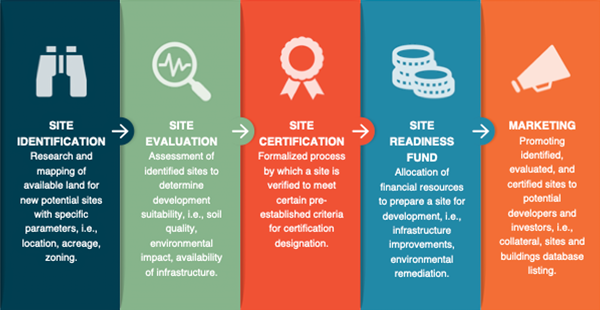Site readiness programs have significantly evolved over the decades, influenced by changing project demands and market trends.
New York pioneered proactive site readiness with the Build Now New York program in the late 1990s. Initially, these programs centered on earning certifications, like a seal of approval — signaling credibility but varying in significance. Today, the focus is on a more flexible approach that addresses various categories of site readiness, though certifications and designations remain integral.
Site readiness has many facets, but at Global Location Strategies (GLS), five aspects in particular stand out in today’s ever-evolving site preparedness strategy.
Site identification. Site identification involves the research and mapping of available land to pinpoint new potential sites based on specific parameters such as location, acreage and zoning. With the surge in U.S. projects, many of the prime sites — those with existing infrastructure and thorough due diligence — are already taken. As the build-ready sites diminish, project requirements are becoming more flexible to mitigate the trade-offs of locations.
To address property portfolio gaps and target strategic end users, states, communities, utilities and other entities are shifting their focus to site identification. Sophisticated identification efforts entail evaluating infrastructure and site conditions at a high level to identify properties that may be suitable for development. The key, and often largest hurdle, of site identification is landowner engagement. Both willingness to sell and a reasonable price are crucial. Site identification is a long game, requiring patience from stakeholders to see the long-term vision. Alas, stakeholder patience can be challenging if they see neighboring communities’ successes without understanding the years of groundwork behind them.
The Missouri Partnership, aiming to attract large-scale industrial users, initiated a statewide megasite identification effort in 2021. Initially targeting large industrial sites of over 1,000 acres, they expanded their focus to include smaller, versatile industrial sites, recognizing broader development opportunities. The results of their efforts included a shortlist of sites to pursue for further readiness efforts and development.

Site evaluation. Site evaluation entails assessing identified sites to determine their suitability for development, focusing on factors like soil quality, environmental impact and the availability of infrastructure. After identifying a potential site, further evaluation is essential to assess its characteristics and utility infrastructure, including potential access to electricity, natural gas, water, wastewater and telecommunications. While detailed improvement plans may not be in place, a general feasibility study should be conducted. Tools like the National Wetlands Inventory (NWI) maps may be used to assess environmental constraints and developability, making site evaluations crucial for determining a property’s viability before committing significant investment dollars.
The Duke Energy Site Readiness Program, initiated in 2005 in the Carolinas, has expanded to include the Florida, Indiana and Ohio/Kentucky Duke territories. By all accounts, the program has been a remarkable success, assessing over 325 sites and catalyzing significant economic growth, including $48 billion in capital investment and the creation of 48,600 jobs.
Site certification. Site certification is a formalized process by which a site is verified to meet pre-established criteria for receiving a certification designation. Site certification standards vary widely, with some programs designed to ensure general site readiness or “shovel-readiness,” while others cater to specific industries like food processing or data centers. Managed by state agencies or outsourced to third-party consultants, these certifications go beyond preliminary evaluations. They require comprehensive environmental due diligence, including Phase I Environmental Site Assessments (ESAs), wetland delineations and geotechnical assessments, alongside a detailed analysis of available utilities. The primary goal of certification programs is to minimize risks related to unknowns, development timelines and cost escalations. Although no site is without risks, stringent certification processes help identify and mitigate them effectively.
Launched in 2012, the CSX SelectSite program was the first railroad-sponsored certification initiative designed to provide thorough site due diligence and ensure sites are rail-accessible. In response to growing demand for rail-served locations, in 2023, CSX enhanced the program by introducing four certification levels — Platinum, Gold, Silver and Bronze. This tiered system helps companies and communities more effectively pinpoint sites that meet specific operational needs. A notable achievement under this program includes the South Alabama Megasite, which achieved certification and secured Novelis in May 2022. This partnership is expected to generate $2.5 billion in capital investment and create 1,000 jobs.
Site readiness fund. This refers to the allocation of financial resources dedicated to preparing a site for development, including infrastructure improvements and environmental remediation. Workforce remains a key driver for projects, yet the focus has increasingly shifted towards sites and infrastructure due to a shortage of ready properties. Many states are now allocating significant funds to advance site development beyond traditional certification, supporting extensive improvements like grading and infrastructure extensions. In more proactive approaches, some states even allow these funds to be used for public entities to acquire sites directly.
Many states are actively enhancing their site readiness through substantial grant programs. In August 2024, the Virginia Economic Development Partnership (VEDP) announced $126 million in grants for 23 sites through the Virginia Business Ready Sites Program (VBRSP). Similarly, starting in 2023, the Alabama Department of Commerce launched the Site Evaluation and Economic Development Strategy Act (SEEDS) grants, allocating up to $30 million to develop industrial sites across both urban and rural Alabama. The initial SEEDS funding round supported 29 grant projects, preparing over 8,400 acres for development. In May 2024, Alabama Secretary of Commerce Ellen McNair announced that thanks to the SEEDs initiative, the state is competing for $13.5 billion in new capital investment and has already secured $30 million in grants, leading to 14 active projects and over 5,000 potential jobs.
Marketing. Marketing involves promoting identified, evaluated, and certified sites to potential developers and investors. Site readiness initiatives offer numerous benefits, such as enhanced stakeholder engagement and strategic advantages. However, the primary objective is to market the prepared sites effectively. Regrettably, some areas that invest heavily in preparing properties fail to match that investment in marketing efforts. To aid in this, most state property databases feature filters or seals to highlight sites that have achieved specific designations.
Florida First Sites, supported by Florida Power and Light, has been continuing a multi-year site readiness program in which each site receives tailored improvement recommendations and investment readiness analyses to boost competitiveness. Unique to this program is its strong emphasis on promotion. Through a partnership with a marketing agency, the program equips participants with essential tools such as property highlight sheets, maps and videos. These resources are designed to empower both FPL and local teams to effectively market the properties, enhancing their visibility and attractiveness to potential developers.
Comparing site readiness programs is akin to comparing apples to oranges, and a national standard could significantly level the playing field. Addressing this gap, the Site Selectors Guild has introduced REDI (Readiness Evaluation for Development and Investment) Sites as a new benchmark for assessing site readiness for U.S. office and industrial projects. Administered by the Guild, REDI Sites offers a searchable database of rigorously assessed properties, setting a consistent standard by the world’s leading site selection consultants. Though still in its nascent stages, this program is poised to revolutionize site selection.
As the site readiness landscape continues to evolve, programs are increasingly focusing on flexibility and strategic depth to enhance marketability and development potential. Maintaining properties at various stages of readiness is not only reasonable but crucial, as it aligns stakeholders and resources early, demonstrating a strong commitment to future investments. A ready site often serves as a critical incentive in today’s economic climate, highlighting the importance of rigorous due diligence, strategic funding and proactive marketing. These elements will be key to meeting the complex demands of modern industries and sustaining community development.

By Sarah White
Principal and Vice President of Site Selection
Global Location Strategies
Greenville, South Carolina
